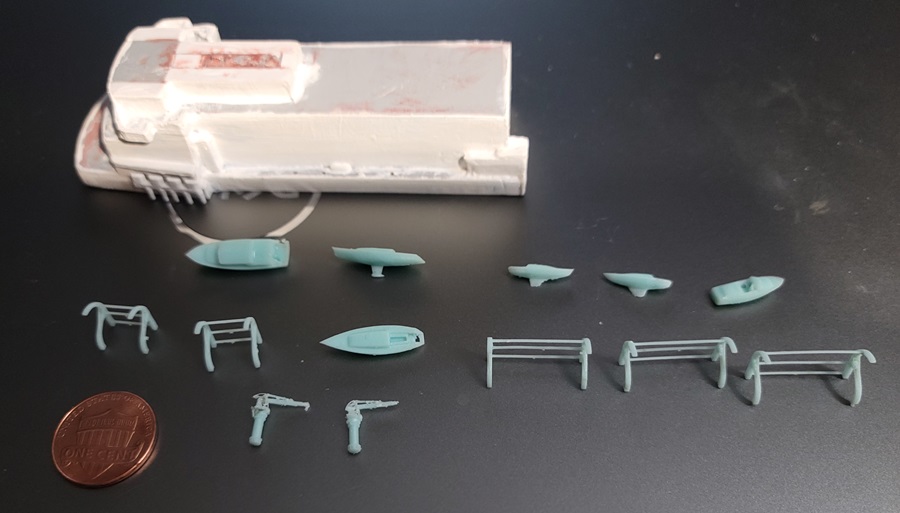10
« Last post by apophenia on Today at 05:23:17 AM »
Of Rockets and Guppies
With the Black Brant sounding rocket programme successfully underway, the rocket propellant team at the Canadian Armament Research and Development Establishment (CARDE), Valcartier, turned its attention to larger vehicles. [1] When the British Saunders Roe Black Prince satellite launch vehicle programme began to stall in the mid-1960s, CARDE and Bristol Aircraft (Western) Ltd. cooperated in the development of a proposed replacement with solid-fuel rocket motors.
For simplicity, this 'new' launch vehicle was to be created using Black Brant rocket motors - with a single rocket second stage booster atop a cluster of five rocket motors forming the first stage. Britain showed no interest, but the Government of Canada agreed to pursue what became the Black Tern programme through NRC research funding. The first test booster - effectively the 5-motor second stage - was assembled at the Churchill Rocket Research Range for test firing in early June of 1965. However, ultimately, this local assembly of components approach was deemed impractical.
Bristol had already begun negotiations to purchase a pair of Canadair North Star transport aircraft when these were retired by the RCAF in 1966. These were to be modified to transport Black Brant components and equipment north to Churchill by air. But aerial delivery of Black Tern second stage assemblies - complete with their bulky transporters - remained impractical due to their overall height. As a result, inquiries were made of Aero Spacelines Inc. in the US which had recently built its outsized 'Pregnant Guppy' conversion of a Boeing Stratocruiser airliner to transport Titan II GLV rocket components for NASA. The latter was much larger than required to carry Black Tern second stages but Aero Spacelines was willing to engineer a scaled-down 'Guppy' for the North Star airframe.
From North Star to 'Polar Bear Express'
Although the North Star-based 'Guppy' would be less bulbous than the original 'Pregnant Guppy', there was a concern that it would be underpowered. There was also the issue of the RCAF having experienced difficulty in acquiring spares for their North Stars' Merlin. Fortunately, Canadair had already completed preliminary engineering work on converting the North Star to turboprop power. As it happened, the old Merlin engine mounting points were identical to those for the Rolls-Royce Dart turbine engines. As a result, the 'Turbo North Star' conversion consisted mainly of finding space for turbine exhaust ports and providing new cowlings, engine controls, etc.
When completed in June 1966, the 'Turbo North Star' conversion was flown to Van Nuys Airport in California. There, Aero Spacelines sheared off most of the North Star's upper fuselage to make way for their 'double-bubble' conversion. This custom Guppy conversion work took almost a year to complete. When finished, the 'Turbo North Star' Guppy was flown north in temporary Aero Spacelines markings. After her brief appearance at the 1967 Abbotsford Airshow, the aircraft was officially delivered back to Bristol in Winnipeg. There, she was remarked as the 'Polar Bear Express' and re-registered as CF-PBX. [2]
Bottom Guppy conversion of 'Turbo North Star' - in temporary ASI markings for the August 1967 Abbotsford Airshow. (The US civil registration N422CA belonged to Aero Spacelines Inc. and was used soley for test-flight and delivery purposes.)
Top 'Turbo North Star' Guppy CF-PBX as she appeared during her first Black Tern delivery to Churchill, Manitoba, in March 1968. The 'Polar Bear Express' markings had been applied in the Autumn of 1967.
By late 1967, the 'Polar Bear Express' had embarked on experimental delivery flights to Churchill. The first Black Tern second stage load was flown north in early March of 1968. Alas, the 'Polar Bear Express' was relatively short-lived. In October 1969, the crew lost visibility on finals into YYQ and CF-PBX made a very heavy landing. The shock of impact on the main undercarriage damaged both wing structures. But the major airframe damage was the result of the nose gear collapsing after the second bounce.
Department of Transport inspectors graded the 'Polar Bear Express' as having suffered Category B damage. As a result, even were it possible, the airframe could not be legally repaired on the spot. Instead, CF-PBX would need to be disassembled and shipped south for depot-level repair by a qualified contractor. Satisfying the DoT was clearly impractical because of its remote location. As a result, the aircraft was stripped for salvage on-site at YYQ. The Dart turboprops and their mounts, propellers, and other salvagable North Star were removed for re-use by the Bristol fleet. After that, the remains of CF-PBX were abandoned in the weeds.
Fortunately, by this stage, the 'Polar Bear Express' was no longer critical to the Black Tern programme. Bristol had already developed and delivered a Black Tern second stage assembly jig to Churchill. This was prompted by the great operating economy of the non-Guppy 'Turbo North Star' fleet. It had been Bristol's plan to lease out the 'Polar Bear Express' for the transport of out-sized cargo - interest having already been expressed by the oil and gas industry in Western Canada. But that was not to be. The flying days of the 'Polar Bear Express' were now well and truly over.
Today, portions of the 'Polar Bear Express' survive at YYQ. The remains had been purchased by a local contractor. With wings and tailplane shorn from the airframe, the cavernous fuselage was converted into a large storage shed.
_____________________________
[1] The CARDE-developed propellant for Black Brant represented the highest-performing solid fuels of their time.
[2] The type-appropriate registration had been acquired from Atlantic Helicopters, a small operator based in Montreal (Atlantic's Sikorsky S-55 c/n 55385 then being re-registrated as CF-PAH).





